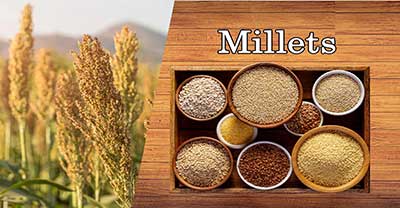Date: 26/10/2022
Relevance: GS-3: Agricultural produce and issues and related constraints
Key Phrases: Nutricereals, International Year Of Millets, Nutritional Security, Lack Of Demand Stimulation, Stagnant Cultivation Of Small Millets, Millet Value Chain Ecosystem, Target Millet’s Marketability With Palatability
Why in News?
- The Gandhinagar-Mumbai Central Vande Bharat Express introduced a low-calorie millet-rich regional menu to travellers made from Ragi, Oats, Muesli, etc. during its inauguration.
- The customised menu is following the theme of the International Year of Millets to be celebrated in 2023 the world over which has been steered by India in the UN General Assembly adopting a resolution in April 2021 and declaring 2023 as the International Year of Millets.
Key Highlights:
- Millets are small-seeded grasses that are hardy and grow well in dry zones as rain-fed crops, under marginal conditions of soil fertility and moisture.
- They are also unique due to their short growing season.
- They offer food, fodder, fuel, and nutrition security and can be grown in intercropping or under mixed cropping with pulses and oil seeds.
- Important millet crops grown in India are Sorghum (Great millet), Bajra (Pearl millet), Ragi (Finger millet) and small millets viz., Korra (Foxtail millet), Little millet, Kodo, Proso and Barnyard millet.
Importance of millets:
- Millets are rich sources of nutrients like carbohydrates, protein, dietary fiber, and good-quality fat and have substantially higher amounts of minerals like calcium, potassium, magnesium, iron, and B complex vitamins, making them a preferable choice over cereal grains.
- The health benefits and nutritional features of millet are well known and it is because of these exceptional qualities that millet is also known as a “superfood”.
- Realising the nutrient richness of the grains they are now gazetted as “Nutricereals” by the Government of India.
Millet as a solution to global food problems:
- As the world is facing the challenges of drylands expansion, soil degradation, and groundwater scarcity, however, there is a lesser possibility of crop improvement of major staple cereals' production.
- Rapid instances of climatic changes have resulted in a major loss of arable land used for crop production causing yield losses.
- In such a situation promoting alternatives to major cereal crops i.e., millet and their cultivation become important as it can solve this problem to a large extent as they can be grown on shallow, low fertile soils with a varied ph-value.
- Millets can be an easy replacement for wheat and rice as they encompass numerous biochemical properties that confer better tolerance to environmental stresses than major cereals.
Reasons for the decline in the millets industry:
- Government policies:
- Although India is the largest producer of millets in the world which are grown in about 21 States, however, the promotion of highly productive varieties of rice and wheat has gradually hindered the expansion of millets production.
- Focus on food security instead of nutritional security:
- During the journey towards food security, nutritional security was not the primary focus, and the availability of other fine cereals such as rice and wheat at an incentivised price through PDS, Mid-day meal scheme (MDM), and other feeding programs hindered the widespread adoption of millet as a staple food.
- Lack of adequate research efforts to improve production and
profitability:
- The inadequate support to research efforts for improving millets cultivation and lower profitability and lack of commercialisation has hindered the progress of millets leading to millets being less remunerative crops due to lower yields.
- The lower productivity of wheat, rice, maize, and millet can be attributed to their cultivation in marginal lands in rain-fed farming and the non-adoption of improved cultivars.
- Lack of dedicated processing machinery and technologies:
- Processing of small millets is a complex process and the lack of processing machinery and diversification of processing technologies dedicated to millets is a big challenge leading to the slow pace of millets promotion.
- Pest and disease resistance of millet crops.
- Though millets have minimal pests and diseases, some pests and diseases often cause significant losses in sorghum (shoot fly, stem borer, grain mold), pearl millet (downy mildew and blast), and finger millet (blast).
- No productive cultivars with highly significant resistance to these pests and diseases are available and management options are mostly limited to agronomic and chemical methods.
- There exists a void in the availability of product-specific cultivars and seed hubs for the breeding and production of high-yield millet seeds which could otherwise help in establishing demand-driven production of millet.
- Other significant problems related to millets include:
- Restricted cultivation
- Lack of demand stimulatio
- Stagnant cultivation of small millets
- Lack of availability of good quality seeds,
- Poor shelf life of millets
- Absence of market linkages
- Lack of uniform standards and grades
Way Forward:
- A successful millet value chain ecosystem is needed with end-to-end solutions for creating demand and mainstreaming millets.
- A systematic network of forward and backward linkages in millets through the involvement of multi-stakeholders in the millet ecosystem must evolve for sharing the expertise in processing and value addition of millets for the benefit of farmers, FPOs, and Self-help Groups (SHGs).
- Development of seed hubs that can deliver quality seed at high production levels is an important intervention required to manage the demand and supply of millet in a better way.
- To maximize the consumption of millet it is necessary to target millet’s marketability with palatability based on taste preferences among people.
- There is also a need to develop popular food items such as biscuits, noodles, savory snacks or chips, etc. from millet which could help in bringing them to the common man’s plate.
Source: Hindu BL
Mains Question:
Q. What are the various issues related to millet cultivation in India? How can millet serve as a solution to global food problems? Suggest measures for mainstreaming of millet in India. (250 words)






















